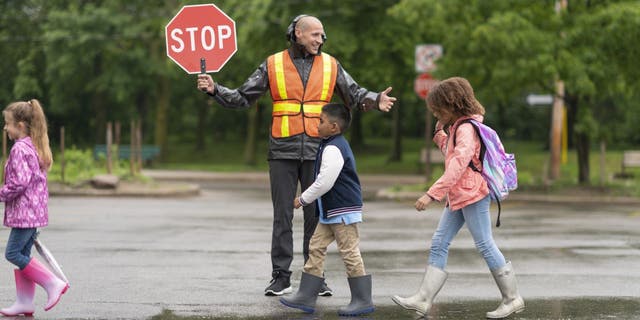NEWYou can now listen to Fox News articles!
A Japanese reality TV show now on Netflix featuring scenes of children carrying out errands outside their homes is sparking debate about the right time — or not — to let kids go out on their own.
“Old Enough!” has aired on Nippon Television on and off since 1991. Recently, Netflix revived it — with 20 episodes from 2013 currently streaming on the platform.
“How is abandoning a tiny child to cross a busy road wholesome?”
The show follows the milestone moments of kids, generally between ages two and six, as they carry out key tasks for their parents, such as making quick grocery store runs or delivering forgotten items. Some kids are also shown traveling to and from school on their own.
U.S. viewers have sounded off on social media, with many saying the show is charming.

The Japanese reality TV show “Old Enough!” made its Netflix debut in April 2022. The popular series follows kids on their first errand. On episode five, a pair of 3-year-olds are tasked with buying dumplings and shrine amulets.
(Courtesy Netflix)
Some, however, have said they can’t see themselves allowing nursery school-age children or kindergartners to take on such challenging tasks alone.
“Is this common in Japan?” said one person. “If so, that’s wonderful that children are safe enough to do this! In the U.S., I couldn’t even imagine what would happen to a child going off on their own like that.”
“Ummm,” said another. “How is abandoning a tiny child to cross a busy road wholesome?”
“It’s the cutest thing I’ve ever seen.”
Fans of “Old Enough!” are defending the content on Twitter.
One person wrote, “It’s the cutest thing I’ve ever seen.”
Another advised people to watch it if they’re “having a bad day.”
Still another wrote, “It’s perfectly safe. There’s an episode where the kid [gets] home really late and it’s already dark. The crew sent a car to light the kid.”
Responding to a recent Facebook post by Netflix that promotes the show, some users shared their own stories about running errands as kids.
One person wrote, “I did this when I was a child as well, age 4+! My mom would hand me some money and I’d go grab bread at the bakery about a mile/half mile away. I always enjoyed doing it because it made me feel like I was helpful and accomplished.”
Another said, “Used to get sent inside the store as a little kid to buy cigarettes when my mom or grandma didn’t want to get out of the car.”
Mieko Fujii, a Japanese instructor at the Japan Culture Center in Chicago, Ill., grew up in the Tokyo Metropolis 60 years ago when there was more freedom to go outside than many kids in Japan have today.
4 TIPS ON RAISING CONFIDENT CHILDREN: PARENTING EXPERTS
Fujii also recalled running errands as a child, just like the kids on “Old Enough!” “That was a different generation. Everybody was so kind and there weren’t so many people or cars,” Fujii said. “[Japan has] very few crimes, so it’s really safe but, you know, with cars and stuff, parents are always worried.”
“There are dangerous things like mountains, hills, rivers and ponds like that,” Fujii said.
The children and parents featured on the show aren’t representative of today’s norm, according to Fujii. In smaller cities, she said it’s possible kids venture out alone in their neighborhoods — but it’s unlikely they’d be sent out on errands under age six.
“There are dangerous things like mountains, hills, rivers and ponds,” Fujii said.
WHY MY CHILDREN DO CHORES
“I spoke with my family in Japan, my son’s family,” Fujii added. “They say around 10 years old is an age when kids can do things by themselves, like visiting a convenience store to buy milk. But [they go] with a cell phone always, so parents can contact them. That’s something they can safely do, but not at [age] three or four or under five.”
Fujii said Japan doesn’t have laws designating an exact age when children can go out on their own or when they can be left home alone. Yet she also noted there are policies that restrict minors from being outside late at night, typically from 11 p.m. to 5 a.m.
Lenore Skenazy, author of “Free-Range Kids,” said parents might want to consider letting kids run errands on their own to build self-esteem.
If caught outside during those prohibited hours, curfew violators are usually reported by police to schools or parents, Fujii said.
When is a child’s exploration ‘responsible’?
Some states in the U.S. have restrictions on the ages a child can be left unsupervised. However, there’s no consistency — which leads to subjective policies and enforcement that sometimes create grief for parents who let kids responsibly explore the world.

Parents should make sure to prepare their kids properly before they step out into the world alone.
(iStock)
That’s according to Let Grow, a New York-based nonprofit promoting childhood independence.
In 2015, a set of Maryland parents were cleared of child neglect after they’d been investigated three times by Child Protective Services. What had they done? They’d allowed their two kids to walk home unsupervised from a local park. The couple was monitored for their advocacy of the free-range parenting style, which encourages childhood independence, as Fox News reported at the time.
So far, Utah, Texas, Oklahoma and Colorado are the only states with Reasonable Childhood Independence laws, said Lenore Skenazy, president of Let Grow and author of “Free-Range Kids.”
These 10 states have age restrictions on kids being left home alone
- Kansas: Age 6
- Georgia, Maryland, North Carolina: Age 8
- North Dakota: Age 9
- New Mexico, Oregon, Washington: Age 10
- Colorado: Age 12
- Illinois: Age 14
“These laws narrow the definition of neglect, protecting parents who — by choice or economic necessity — give their kids some unsupervised time, for instance, to run an errand,” Skenazy told Fox News Digital in an interview.
Skenazy, who holds a bachelor’s in American studies and a master’s in journalism, said parents might want to consider letting kids run errands on their own to build self-esteem. Ideally, this self-esteem should be strong enough to combat mental health issues such as depression and anxiety, Skenazy said.
Letting kids run errands alone: Is it safe?
Experts agree the situation depends on a child’s maturity level, the environment and a knowledge of safety precautions.
“Obviously every neighborhood, and every child, is different,” said Skenazy. “It’ll depend on your kid, your neighborhood and all sorts of things like whether there are sidewalks or stop signs or roving bands of rabid wolves.”
UTAH LEGALIZES ‘FREE-RANGE PARENTING’
Skenazy noted that if a parent or guardian has a hard time crossing a busy street, then a child will surely have a hard time, too.
“[But] if it’s simply a matter of teaching [children] to look both ways — which is what I was taught as a kid, ‘Look left, look right, look left again’ — then our job as parents is to make sure they understand when, why and how to do this,” she continued.
“Really, the thing to do is to walk to [key destinations] with your child a few times to teach them how to navigate — and anything they should be watching out for.”

This young child’s second task on an episode “Old Enough!” involved picking up a watch from a local watch shop. Members of her community made sure to cheer her on while she handled the task.
(Courtesy Netflix)
Skenazy watched “Old Enough!” and noticed that the parents on the show aren’t without worry or nervousness — and that child participants are “sometimes a little scared, too.”
“What’s interesting about ‘Old Enough!’ is that worry alone is not considered reason enough to not let a child start doing something,” Skenazy said. “The reason the show is so charming is that the kids and their parents triumph over some worries and hiccups.”
‘FREE-RANGE KIDS’ AND THE DANGERS OF AN OVERPROTECTIVE SOCIETY
Said Skenazy, “There can be no growth without trying something new and a little daunting. Seeing your kid blossom is even more powerful than worrying about their every move.”
Fujii, for her part, said that in Japan, children as young as five or six years old can be seen commuting to schools, parks or the homes of neighbors without their parents.
“Seeing your kid blossom is even more powerful than worrying about their every move.”
This is especially true for a group of children called “hochigo,” which translates to “left-alone child.” This shares similarities with the term “latchkey kid” once used in the U.S. This group of children often gets left alone when parents have busy work schedules, Kyodo News reported in 2019.
MOM SLAMMED ON TIKTOK FOR FEEDING BABY ‘BLOODY’ STEAK: EXPERTS WEIGH IN
Even so, Fujii said the children on “Old Enough!” aren’t part of this group; the show instead focuses on the “cute” nature of child independence.
From an early age, Japanese children are taught how to take care of themselves, their environment and their community. “That’s the most important thing in our culture,” Fujii said.

In episode 7 of “Old Enough!” on Netflix, a toddler named Miro is tasked with delivering her father’s apron to his restaurant, which is located two streets away from their home.
(Courtesy Netflix)
Devon Kuntzman, founder of Transforming Toddlerhood, a parenting coaching service, told Fox News Digital that errand-running for children depends on many factors, including the kids’ maturity, how much they’ve practiced and where they live.
She said that “many cities in Japan are more pedestrian-friendly than in the U.S.” and “are set up for pedestrians to walk safely.” The U.S. has “many communities” that are spread out and “aren’t designed for children to walk.”
PARENTS WHO LET KIDS WALK HOME ALONE TO APPEAL ‘UNSUBSTANTIATED’ FINDING IN NEGLECT CASE
“The U.S. has a more individualistic culture these days compared to 60 to 70 years ago, when everyone knew their neighbors and communities were more cohesive,” Kuntzman said, offering her opinion. “Using the buddy system or having a group of kids with some older kids present would be more safe overall.”

Kids should learn how to cross streets properly before they can be trusted to walk outside alone.
(iStock)
Skenazy noted that young children aren’t ready for the “real world” even if they have a higher understanding because they need instruction and experience in order to succeed.
“If you want your child to learn how to cross the street, you can’t just say, ‘You’re five. Goodbye!’” Skenazy said. “You have to teach kids to look out for cars and pay attention to the ‘walk’ signs, and make themselves seen in the crosswalk — all that stuff.”

Kids can practice their navigation skills to and from school when they travel in a group.
(iStock)
And a child’s instructor doesn’t always have to be a parent, she said. It could include a family friend, an older child, a babysitter or someone else who knows how to safely conduct himself or herself on an errand.
“What we want to do is build independence from a young age by giving kids tasks around the home or [by letting kids] run errands on foot with you,” Skenazy continued. “From there, the goal is to scaffold or scale their skills until they are confident in doing larger tasks and errands on their own.”
Errands or chores to start with your kids
If you think your child isn’t ready to go on a solo errand, assign tasks to build stepping stones to independence.
“Kids are desperate to help out around the house,” Skenazy told Fox News Digital. “Anthropologist David Lancy says that this desire peaks around age 3 or 4 and then gradually goes ‘extinct’ if they’re constantly told, ‘No, you can’t help yet.’”
‘LAWN MOWER PARENTS’ ARE THE NEW ‘HELICOPTER MOMS’
She said it’s “best” to let kids contribute when they’re “most psyched.” Some tasks that can be handled by children include cooking, cleaning and caring for pets or younger siblings, within reason.

Children can run errands and do chores around the house before they get to travel far distances alone.
(iStock)
Kuntzman said she thinks the kitchen is a “great place” to let children help out.
“Start with mixing and pouring skills. Then move onto measuring and using child safe knives,” Kuntzman suggested. “Next, [the kids] can move to cooking alongside you, and then eventually to cooking on their own.”
MOM SHARES BABY MEDICINE HACK IN VIRAL TIKTOK: ‘WORKED LIKE A CHARM’
She said it’s important for children to “master” all of these individual skills before they’re trusted to cook alone.
Outside the home, Kuntzman said parents can set the foundation for future errand-running by giving kids small tasks such as locating products in stores or using a card or cash to pay for items.

Kids can practice shopping when they accompany an adult in a store.
(iStock)
As for letting kids head out solo, Skenazy stressed that kids need to be able to look out for cars and know how to identify landmarks. She also said she recommends teaching children, “They can talk to anyone. They cannot go off with anyone.”
CLICK HERE TO GET THE FOX NEWS APP
“This is much better than teaching them, ‘Don’t talk to strangers,’ in part because if kids think they can’t talk to any adults, they won’t be able to ask for help if they should ever need it,” Skenazy said. “It’s hard to figure out who’s a stranger. If Mom talked to the cashier at the store, is the cashier a friend or a stranger?”
Kuntzman said kids should also know their phone number and address along with identification. Many of these essential life skills can be practiced on supervised outings until children have proven they can do it alone.
“If Mom talked to the cashier at the store, is the cashier a friend or a stranger?”
“A child having a cellphone for the outing and knowing basic self-defense can definitely be a plus,” Kuntzman added.

When kids demonstrate that they can handle going out alone, they can join their friends on social outings.
(iStock)
E.L. Forestal, founder of FindBlackTherapist.com, an online mental health provider network, suggested parents let kids start with “short, low-stress outings.”
He said parents can talk with them through fears, and how respond to challenges or dangers such as getting lost, being bullied or encountering a dangerous animal.
FOLLOW US ON FACEBOOK FOR MORE FOX LIFESTYLE NEWS
Setting up a check-in system gives a child a place to turn if something urgent comes up, he added.